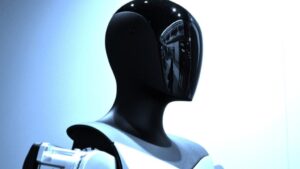Tesla’s Optimus: A Game-Changer in Robotics and Revenue
Elon Musk recently made a bold prediction about Tesla’s future endeavors with its Optimus humanoid robot, suggesting that the revenue potential of this innovative technology could surpass $10 trillion. This statement captures more than just Musk’s typical enthusiasm; it indicates a pivotal shift in the robotics landscape and how companies—and investors—should prepare for this change.
The Production Launch: What to Expect
Musk announced that Tesla plans to roll out several thousand units of its Optimus robot this year. These units are set to perform menial tasks within Tesla’s factories, thereby enhancing production efficiency by freeing human workers from less favorable work. The insights gained from this initial roll-out will shape the next iteration of Optimus, which is expected to launch mid-next year.
This strategy showcases Tesla’s dual approach of using its own operations to refine technology before introducing it to the market. This not only accelerates development but also positions Tesla as a leader in the robotics sector.
Revenue Predictions: A Leap into the Future
Musk’s ambitious forecasting includes a revenue estimate for Optimus that some might dismiss as overly optimistic. Yet, Musk himself acknowledges that while these projections may sound “absolutely insane,” he believes they will ultimately be validated. “My prediction long-term is that Optimus will be overwhelmingly the value of the company,” he confidently states, suggesting a fundamental rethinking of Tesla’s business model that could greatly diversify its revenue streams.
Notably, Musk also revealed that once production reaches a million units annually, the manufacturing costs of Optimus would drop below $20,000. This affordable pricing, combined with expected high demand, could solidify Optimus as not just a tool for Tesla, but a household necessity worldwide.
The Bigger Picture: Market Potential and Implications
Musk envisions a world where there will be at least one humanoid robot for every person. With a global population exceeding 8 billion, that suggests a market potential of over 10 billion humanoid robots in the future—and Tesla is positioning itself to capture a significant share of this market.
At a recent shareholder meeting, Musk claimed that while the autonomous vehicle market could see a valuation between $5-$7 trillion, the humanoid robot sector might skyrocket to a staggering $25 trillion. This juxtaposition illustrates how robotics, particularly in consumer and industrial applications, could redefine various markets.
Industry Reactions and Technological Advancements
In recent demonstrations, Tesla showcased its Optimus robots, which performed tasks from pouring drinks to interactive dance moves. While these demonstrations involved some human assistance, the capabilities of these robots are scaling rapidly. “The toughest part by far is improving the design of Optimus for ease of manufacturing and tooling up a complex supply chain,” Musk noted. These challenges highlight the intricate balance of innovating technology while keeping production viable and economically feasible.
Final Thoughts: A Driver of Investor Interest
As Tesla inches closer to its ambitious goals, investors would be wise to keep a close eye on these developments. The integration of robotics into Tesla’s core business not only signals diversification but also a competitive edge that could redefine industry standards. For those exploring investment avenues, the Optimus project could represent a groundbreaking opportunity amidst the complexities of the tech market.
Interested in the evolving landscape of robotics and the potential returns it offers? Follow us for updates on revolutionary investments that keep you ahead of the curve. Stay informed, and let Extreme Investor Network guide you through these exciting financial waters—where innovation meets profit potential.

